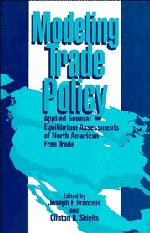Book contents
- Frontmatter
- Contents
- List of Contributors
- Dedication
- Part I Introduction
- Part II Multisector Models
- Part III Sector-Focused Models
- 6 Agriculture in the Mexico-U.S. Free Trade Agreement: A General Equilibrium Analysis
- 7 Wage Changes in a U.S.-Mexico Free Trade Area: Migration Versus Stolper-Samuelson Effects
- 8 The Auto Industry and the North American Free Trade Agreement
- 9 Trade Liberalization in Quota-Restricted Items: The United States and Mexico in Textiles and Steel
- Part IV Dynamic Models
- Index
7 - Wage Changes in a U.S.-Mexico Free Trade Area: Migration Versus Stolper-Samuelson Effects
Published online by Cambridge University Press: 25 March 2010
- Frontmatter
- Contents
- List of Contributors
- Dedication
- Part I Introduction
- Part II Multisector Models
- Part III Sector-Focused Models
- 6 Agriculture in the Mexico-U.S. Free Trade Agreement: A General Equilibrium Analysis
- 7 Wage Changes in a U.S.-Mexico Free Trade Area: Migration Versus Stolper-Samuelson Effects
- 8 The Auto Industry and the North American Free Trade Agreement
- 9 Trade Liberalization in Quota-Restricted Items: The United States and Mexico in Textiles and Steel
- Part IV Dynamic Models
- Index
Summary
Introduction
A major issue concerning the establishment of a North American free trade agreement (NAFTA) is its impact on wages in Mexico and the United States. One argument is that the agreement will result in higher wages for unskilled labor in Mexico but lower wages for unskilled labor in the United States. This view can be derived from the Stolper–Samuelson theorem, which links changes in wages and profits to the changes in product prices caused by trade liberalization. Mexico is abundant in unskilled labor relative to the United States, and trade reform will increase Mexico's relative price of manufactured goods that it exports to the United States. According to the theorem, unskilled wages will fall in the United States and rise in Mexico as Mexican exports displace U.S. production of labor-intensive goods.
There are a number of difficulties in applying the Stolper–Samuelson theorem to the case of NAFTA. First and foremost is that the two countries are linked by more than trade in commodities. In particular, there is a long history of labor migration between Mexico and the United States, and one would expect that such migration would be sensitive to wage changes brought about by NAFTA. When using the Stolper–Samuelson theorem, one assumes that aggregate factor supplies are constant and that shifts in labor demand curves determine wage changes. However, the effects of trade liberalization on wages can be ambiguous when there is international labor mobility, which shifts the labor supply curve as well.
- Type
- Chapter
- Information
- Modeling Trade PolicyApplied General Equilibrium Assessments of North American Free Trade, pp. 195 - 222Publisher: Cambridge University PressPrint publication year: 1994
- 5
- Cited by



